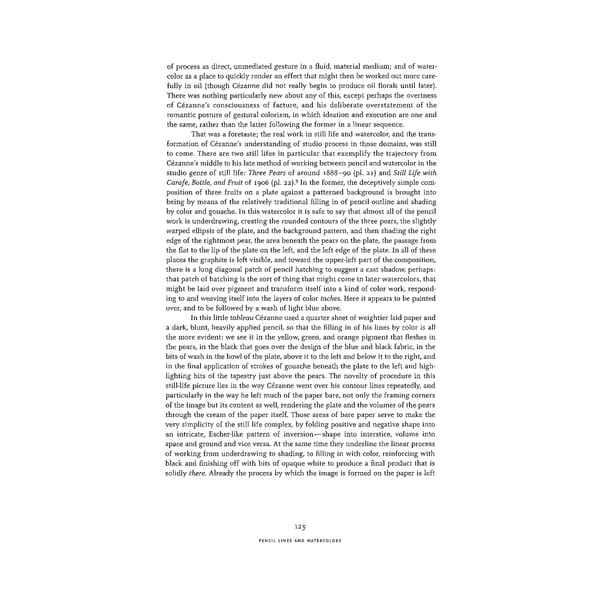of process as direct, unmediated gesture in a fluid, material medium; and of water- color as a place to quickly render an effect that might then be worked out more care- fully in oil (though Cezanne did not really begin to produce oil florals until later). There was nothing particularly new about any of this, except perhaps the overtness of Cezanne's consciousness of facture, and his deliberate overstatement of the romantic posture of gestural colorism, in which ideation and execution are one and the same, rather than the latter following the former in a linear sequence. That was a foretaste; the real work in still life and watercolor, and the trans- formation of Cezanne's understanding of studio process in those domains, was still to come. There are two still lifes in particular that exemplify the trajectory from Cezanne's middle to his late method of working between pencil and watercolor in the studio genre of still life: Three Pears of around 1888-90 (pi. 21) and Still Life with Carafe, Bottle, and Fruit of 1906 (pi. 22).9 In the former, the deceptively simple com- position of three fruits on a plate against a patterned background is brought into being by means of the relatively traditional filling in of pencil outline and shading by color and gouache. In this watercolor it is safe to say that almost all of the pencil work is underdrawing, creating the rounded contours of the three pears, the slightly warped ellipsis of the plate, and the background pattern, and then shading the right edge of the rightmost pear, the area beneath the pears on the plate, the passage from the flat to the lip of the plate on the left, and the left edge of the plate. In all of these places the graphite is left visible, and toward the upper-left part of the composition, there is a long diagonal patch of pencil hatching to suggest a cast shadow, perhaps: that patch of hatching is the sort of thing that might come in later watercolors, that might be laid over pigment and transform itself into a kind of color work, respond- ing to and weaving itself into the layers of color taches. Here it appears to be painted over, and to be followed by a wash of light blue above. In this little tableau Cezanne used a quarter sheet of weightier laid paper and a dark, blunt, heavily applied pencil, so that the filling in of his lines by color is all the more evident: we see it in the yellow, green, and orange pigment that fleshes in the pears, in the black that goes over the design of the blue and black fabric, in the bits of wash in the bowl of the plate, above it to the left and below it to the right, and in the final application of strokes of gouache beneath the plate to the left and high- lighting bits of the tapestry just above the pears. The novelty of procedure in this still-life picture lies in the way Cezanne went over his contour lines repeatedly, and particularly in the way he left much of the paper bare, not only the framing corners of the image but its content as well, rendering the plate and the volumes of the pears through the cream of the paper itself. Those areas of bare paper serve to make the very simplicity of the still life complex, by folding positive and negative shape into an intricate, Escher-like pattern of inversion—shape into interstice, volume into space and ground and vice versa. At the same time they underline the linear process of working from underdrawing to shading, to filling in with color, reinforcing with black and finishing off with bits of opaque white to produce a final product that is solidly there. Already the process by which the image is formed on the paper is left 125 PENCIL LINES AND WATERCOLORS
 Cézanne in the Studio: Still Life in Watercolors Page 139 Page 141
Cézanne in the Studio: Still Life in Watercolors Page 139 Page 141